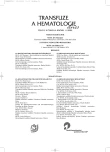Selection of blood donors for the multicomponent blood collection
Výběr dárců pro multikomponentní odběry krve
Úvod.
Multikomponentní odběry jsou moderní alternativou odběrů dárců krve, jednotná výběrová kriteria pro dárce dosud nebyla stanovena. Cílem práce bylo tato kritéria blíže upřesnit.
Metoda.
U provedených multikomponentních odběrů bylo provedeno vzájemné posouzení vstupních parametrů dárců krve, parametrů aferéz a jakosti získaných transfuzních přípravků, byl zhodnocen význam výběrových kritérií pro jednotlivé typy multikomponentních odběrů.
Výsledky.
U 137 dárců bylo provedeno 250 odběrů na separátoru Haemonetics MCS+ a 44 odběrů na separátoru TRIMA Accel (dvojité erytrocytaferézy a kombinované odběry trombocytů). Odběry trvaly 36–81 minut podle typu protokolu, odebíraný objem byl 7–13 % celkového objemu krve (TBV) u obou separátorů, jakost přípravků splnila požadovaná kritéria. U trombocytaferéz s plazmou byl průměrný předodběrový počet trombocytů dárce významně nižší u separátoru TRIMA Accel, TBV dárce neměl vliv na trvání aferézy ani na jakost přípravků.
Diskuse.
Výsledky práce ukazují na nutnost vybírat dárce diferencovaně podle jenotlivých přístrojů a protokolů, klíčovým parametrem pro výběr dárce pro kombinované trombocytaferézy je předodběrový počet trombocytů dárce, hodnota TBV je limitujícím faktorem zejména pro volbu objemu odebíraných přípravků. Použití výběrových kritérií Rady Evropy pro dvojité erytrocytaferézy je třeba doplnit o monitorování zásob železa dárce krve.
Klíčová slova:
multikomponentní odběr krve, výběrová kritéria dárce, jakost transfuzních přípravků
Authors:
R. Procházková; L. Hubáčková; L. Řehořová
Authors‘ workplace:
Transfuzní oddělení, Krajská nemocnice Liberec
Published in:
Transfuze Hematol. dnes,11, 2005, No. 2, p. 54-61.
Category:
Comprehensive Reports, Original Papers, Case Reports
Overview
Introduction.
Multicomponent collection belongs to the modern alternative of the blood donation. Uniform criteria for selection of donors have not been established yet. The aim of this study was to specify these criteria.
Methods.
The reciprocal analysis of entry parameters, apheretic parameters, and quality of blood components were compared in performed multicomponent collections. Significance of selected criteria for individual types of multicomponent collections was evaluated.
Results.
Two hundred fifty collections were performed in 137 blood donors using Haemonetics MCS+ separator and 44 collections using TRIMA Accel separator (2 unit red cell apheresis and combined thrombocytapheresis). The collections lasted from 31 to 81 minutes according to the type of protocol. The collected volume was 7 to 13 % from the total blood volume (TBV) in both separators, and the quality of components met required criteria. Using TRIMA Accel, the mean platelet count in blood donors before donation was significantly lower, and TBV did not affect duration of apheresis nor quality of the components.
Discussion.
Results of this study indicate the necessity of the selection of blood donors in accordance to both devices and protocols. Key factor for the selection of blood donors for combined thrombocytapheresis is platelet count before donation. The value of TBV is one of the limiting factors particularly for selection of the volume of the components. Selection criteria of Council of Europe for 2 unit red blood cell apheresis are necessary to be completed about monitoring of blood donor storage iron.
Key words:
multicomponent blood collection, selection criteria for donors, quality of blood components
Labels
Haematology Internal medicine Clinical oncologyArticle was published in
Transfusion and Haematology Today

2005 Issue 2
- Cost Effectiveness of FVIII Substitution Versus Non-Factor Therapy for Hemophilia A
- Vascular Disease in the Gradually Aging Population of Hemophiliacs: An Underestimated Problem?
- Prognostic Significance of Subclinical Joint Changes on MRI in Hemophilia
- Immunotolerance is still the goal of management of hemophilia A with inhibitor in the era of non-factor therapy
- Minimum and Optimal Factor Levels in Physically Active Hemophiliacs
Most read in this issue
- Hodgkin’s lymphoma therapy results with a view to the treatment of relapses and primary progression
- Clinical significance of the evaluation of serum levels of immunoglobulin free light chains in monoclonal gammapathies
- LIFE 18 – the first contact with an integrated device for treatment by means of immunoadsportion
- Selection of blood donors for the multicomponent blood collection
